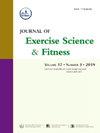Feasibility and effects of high-intensity interval training in older adults with mild to moderate depressive symptoms: A pilot cluster-randomized controlled trial
IF 2.4
2区 医学
Q2 SPORT SCIENCES
引用次数: 0
Abstract
Background
Older adults with mild-to-moderate depressive symptoms (MMDS) are at high risk of developing severe depression along with mortality and disability. The aim of this study was to investigate the feasibility and preliminary effects of high-intensity interval training (HIIT) in older adults with MMDS in a small sample size.
Methods
Three elderly centers involving 24 older adults with MMDS were randomized into: 1) HIIT (n = 8); 2) moderate-intensity continuous training (Baduanjin Qigong) (MICT-BDJ) (n = 8); or 3) recreation workshop (RW) control (n = 8) for 16-week (32 session) intervention. Feasibility was assessed using retention rate, session attendance rate, exercise intensity adherence, acceptability, and safety. Depressive symptoms were assessed using the Chinese version of the 15-item Geriatric Depression Scale, while physical fitness (PF) was measured using the Senior Fitness Test. Depressive symptoms and PF were evaluated at baseline and post-intervention.
Results
20 participants completed data collection twice. The retention rate was 87.5 % (7/8), 87.5 % (7/8), 75 % (6/8) for HIIT, MICT-BDJ, and RW, respectively. 87.5 % (7/8) of HIIT participants completed at least 75 % of exercise sessions. 81.4 % of HIIT participants achieved pre-designed intensity (≥80 % maximum heart rate) during high-intensity intervals. All HIIT (7/7) participants were satisfied with their group allocation. More HIIT (6/7) than MICT-BDJ (5/7) participants found exercise enjoyable. Two mild adverse events were reported in HIIT group. HIIT improved depressive symptoms more than MICT-BDJ (d = -1.02) and RW (d = -1.32). Both HIIT (d = 1.26) and MICT-BDJ (d = 1.39) improved PF more than RW.
Conclusions
This study provides preliminary evidence on the feasibility and effect of HIIT for older adults with MMD. Both HIIT and MICT-BDJ improved depressive symptoms and PF. HIIT demonstrated better efficacy in depressive symptoms and mobility than MICT-BDJ. The findings should be interpreted cautiously due to several limitations. The rigorous cluster randomized controlled trial with large-scale sample size is warranted in the future to affirm the current findings.
Trial registration
Trial Registration: NCT06014294.
高强度间歇训练对轻度至中度抑郁症状老年人的可行性和效果:一项先导集群随机对照试验
背景:患有轻度至中度抑郁症状(MMDS)的老年人发展为重度抑郁症、死亡率和致残的风险很高。本研究的目的是在小样本范围内探讨高强度间歇训练(HIIT)在老年MMDS患者中的可行性和初步效果。方法3个老年中心共纳入24名老年MMDS患者,随机分为:1)HIIT组(n = 8);2)中强度连续训练(八段锦气功)(MICT-BDJ) (n = 8);或3)娱乐工作坊(RW)对照(n = 8)进行16周(32次)干预。可行性评估采用保留率、会话出勤率、运动强度依从性、可接受性和安全性。抑郁症状采用中文版老年抑郁量表,体适能(PF)采用老年适能测试。在基线和干预后评估抑郁症状和PF。结果20名参与者完成了2次数据收集。HIIT、MICT-BDJ、RW的保留率分别为87.5%(7/8)、87.5%(7/8)、75%(6/8)。87.5%(7/8)的HIIT参与者完成了至少75%的锻炼。81.4%的HIIT参与者在高强度间歇达到了预先设计的强度(≥80%最大心率)。所有HIIT(7/7)参与者都对他们的分组分配感到满意。HIIT参与者(6/7)比mit - bdj参与者(5/7)更喜欢锻炼。HIIT组轻度不良事件2例。HIIT比mic - bdj (d = -1.02)和RW (d = -1.32)更能改善抑郁症状。HIIT (d = 1.26)和MICT-BDJ (d = 1.39)对PF的改善均优于RW。结论本研究为HIIT治疗老年烟雾病的可行性和效果提供了初步证据。HIIT和MICT-BDJ均能改善抑郁症状和PF, HIIT在抑郁症状和活动能力方面的疗效优于MICT-BDJ。由于一些局限性,研究结果应谨慎解释。未来需要进行严格的大样本量的集群随机对照试验来证实当前的发现。试验注册:NCT06014294。
本文章由计算机程序翻译,如有差异,请以英文原文为准。
求助全文
约1分钟内获得全文
求助全文
来源期刊
CiteScore
5.10
自引率
3.60%
发文量
54
审稿时长
31 days
期刊介绍:
The Journal of Exercise Science and Fitness is the official peer-reviewed journal of The Society of Chinese Scholars on Exercise Physiology and Fitness (SCSEPF), the Physical Fitness Association of Hong Kong, China (HKPFA), and the Hong Kong Association of Sports Medicine and Sports Science (HKASMSS). It is published twice a year, in June and December, by Elsevier.
The Journal accepts original investigations, comprehensive reviews, case studies and short communications on current topics in exercise science, physical fitness and physical education.

 求助内容:
求助内容: 应助结果提醒方式:
应助结果提醒方式:


